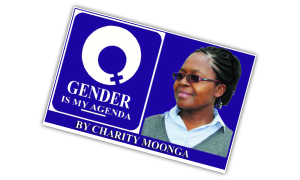VIOLENCE against women has been defined as any act of Gender Based Violence (GBV) that results in, or is likely to result in physical, sexual or psychological harm or suffering to women.
This includes threats of such acts, coercion or arbitrary deprivation of liberty, whether occurring in public or in private.
Violence against women is one of the most shameful human rights violations.
It knows no boundaries of geography, culture or wealth.
As long as it continues, Zambia cannot claim to be making real progress towards attaining lasting equality, development and peace.
It is necessary to note that the media has the potential to play a significant lead role in changing perceptions of GBV, which in turn can help to stimulate change.
GBV includes psychological violence, which is any threatening conduct, coercion, verbal insulting and similar behaviour impairing a woman’s mental health.
Stalking is any threatening conduct that makes a woman fear for her safety.
Sexual violence, including rape, is any non-consensual penetration of sexual nature of woman’s body.
Economic violence is being denied access to money or any opportunity for making existential decisions.
Genital mutilation, forced abortion and forced marriage are also forms of violence against women.
Cyber violence is characterised by threats and insults shared across social media platforms (Facebook, YouTube) using digital technology (e-mail, mobile phones, etc) and control exercised through such conduct.
The common perpetrators of violence are current and or former partners and fathers.
The most common type of violence suffered by women is psychological violence and violence that is both physical and psychological.
Women and girls are subjected to different forms of violence every day.
In the ongoing COVID-19 pandemic, there has been an alarming rise in GBV and crimes, such as rape, molestation, dowry deaths, domestic abuse and cybercrimes.
Research has shown that responsible media reporting can mitigate the risk of GBV.
However, media reporting has revealed that reporting about violence against women tends to be sensational; the more brutal, the more appealing.
It is necessary to note that if women are portrayed only as victims, it will exacerbate their victimization and send a message that they are weak and powerless and that it is best for them to “endure silently”.
Stereotypical portrayal of women as a “weaker sex” and men as “macho protectors” reflects those very social values that define domestic violence as a “common” and inevitable part of marriage.
Portraying women only as victims in the media furthers their victimization, even though there are many examples of women who have fought back and broken the cycle of violence.
The media should not merely report the facts of the event.
Questions raised in their reports can inspire others not to turn a blind eye and not to turn up the volume on their television sets when they hear screams and furniture crashing in the apartment next door.
The public needs to understand that violence is not some kind of a theatrical play of no concern to them.
They should understand that by intervening, they may save someone’s life.
Balanced media reporting violence against women
Avoid mentioning identifying details of the victim (such as age/occupation), location of the incident (such as abandoned buildings, old warehouses), photograph of the location and description of the steps involved in the crime (such as lured the woman on the pretext of marriage), judgmental language (regarding survivor’s history, clothes, whereabouts at the time of the event).
Mentioning these details in the report may contribute to victim shaming, besides providing clues to perpetrators.
The media should focus on providing support service details such as hotlines, shelters and crisis centres and draw attention towards positive stories of resilience and empowerment as survivors often act as agents of change
Strategies to promote media role in preventing violence against women
There is need for a collaborative approach between the Government, media and health professionals that takes into account the barriers and perspectives of media.
Make responsible media reporting of GBV a mandatory part of the training curriculum for journalists and editors.
Television channels may consider hosting periodic talk shows or interviews with experts on various aspects of GBV and crimes against women.
Constitute a national media monitoring agency to monitor the quality of news articles depicting
GBV in the media on a daily basis, and second, to increase awareness about the role of media as a population level prevention strategy to deal with the menace.
This agency may also be tasked with imparting regular training to media personnel.
Placement of content pertaining to violence against women should be strategic.
This content should be made significantly more visible in the media.
The media should not use GBV stories to boost ratings or circulation and they should avoid sensationalistic headlines.
The media should be careful in transmitting scenes of violence that could be easily imitated and that involve tools that are easy to find, such as knives, hammers, picks, etc.
Footage that transmits scenes of violence should be broadcast at specific times.
The reporting of violence against women cannot and should not encourage the concept that they are victims who accept the violence.
The use of violence cannot be considered as a normal phenomenon.
Therefore, underestimating the consequences of violence increases the risk that it could become acceptable.
Journalists should carefully choose language when reporting on violence against women and
always avoid implying that the survivor is to blame.
The media should conduct all contact with survivors of abuse or violence with respect for their experience, dignity, privacy and safety.
A better exchange of information between Non-Governmental Organizations (MGOs) working on these issues, institutions and media.
Other tips for covering GBV in the media
• Find out what the relationship was between the perpetrator and the victim(s).
• Be aware of how source selection influences the story.
• Search for patterns of violence and control.
• Pay attention to language.
• Consider the interests of survivors of GBV.
• Educate people about GBV and why it happens.
• Explain the reasons why women appear to “put up with” GBV (i.e. why women stay in abusive relationships/environments) and the dangers in leaving.
• Consider the safety of the person being interviewed.
• Protect children’s privacy.
• Correct errors.
• Draft questions so they are not judgmental.
• Don’t focus on sensationalist information (i.e. blood in domestic violence/sexual assault cases, /sexual harassment cases etc.)
• Do not assume that certain cultures or classes are violent
• Be careful of sources who are emotionally involved with the perpetrator.
• Avoid quoting distant acquaintances/colleagues.
What to avoid – The Don’ts…
If you are writing about violence against women, refrain from the following:
Revealing identities of the perpetrator, victim and children involved.
Using generic images depicting blood, bruises, brutality or the victim and the perpetrator in question.
Relying only on police reports and statements of relatives or neighbours.
Sensationalistic sentences, dramatic headlines and sub-headlines.
Writing about violence against women only when violence or murder has been committed.
Use more than one source – you can include NGOs or some institutions.
The media is one of the most important socializing influences in people’s lives.
Negative and stereotypical images of women in the media, and the ways in which the media reports GBV (as a lesser crime or violation) contributes to the acceptance of gender-based violence.
The media informs people’s understanding of issues, and, therefore, has a critical role to play in eliminating violence against women.
Comments: moongacharity10@gmail.com.







